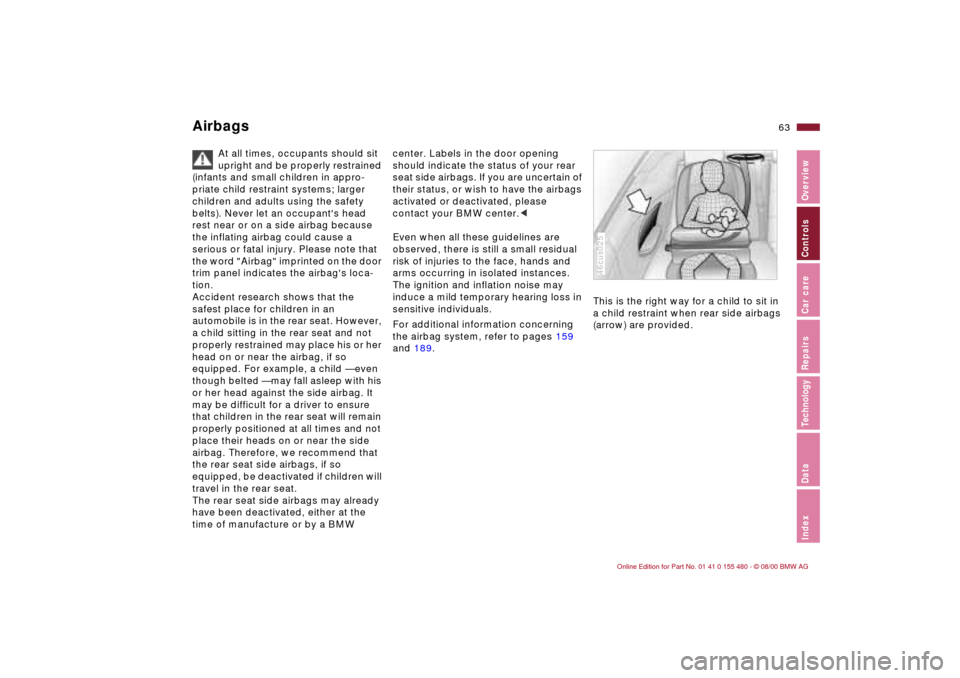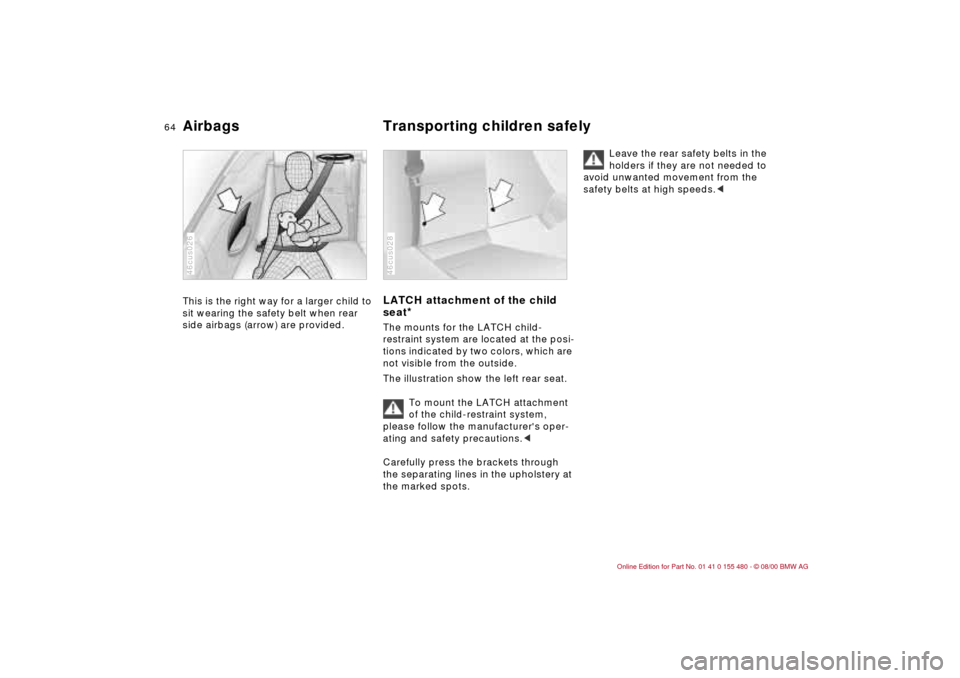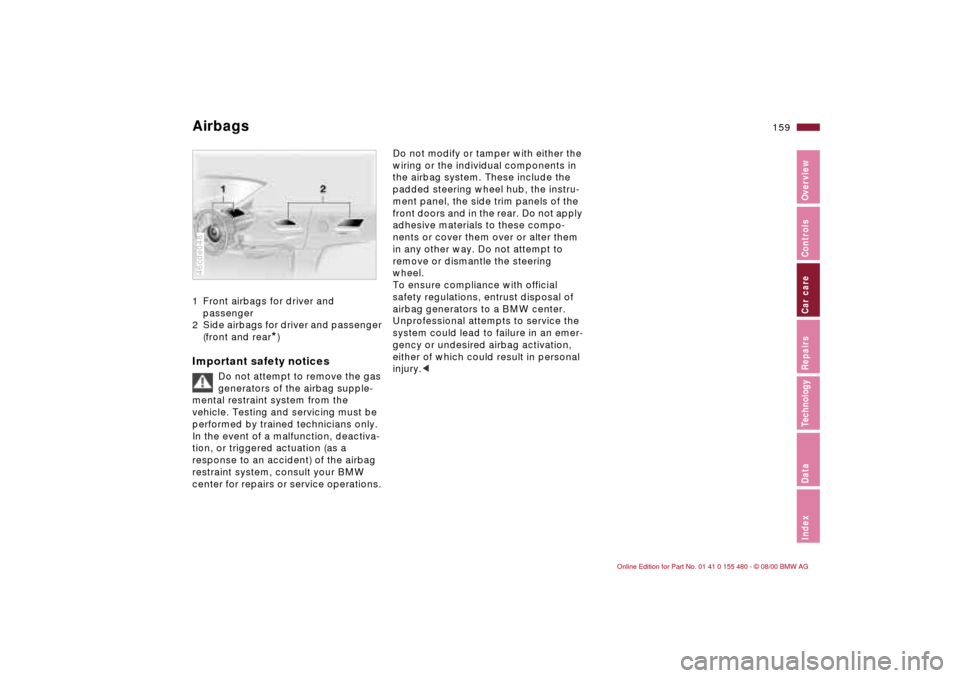2001 BMW 330Ci CONVERTIBLE airbag
[x] Cancel search: airbagPage 63 of 215

63n
IndexDataTechnologyRepairsCar careControlsOverview
Airbags
At all times, occupants should sit
upright and be properly restrained
(infants and small children in appro-
priate child restraint systems; larger
children and adults using the safety
belts). Never let an occupant's head
rest near or on a side airbag because
the inflating airbag could cause a
serious or fatal injury. Please note that
the word "Airbag" imprinted on the door
trim panel indicates the airbag's loca-
tion.
Accident research shows that the
safest place for children in an
automobile is in the rear seat. However,
a child sitting in the rear seat and not
properly restrained may place his or her
head on or near the airbag, if so
equipped. For example, a child Ñ even
though belted Ñ may fall asleep with his
or her head against the side airbag. It
may be difficult for a driver to ensure
that children in the rear seat will remain
properly positioned at all times and not
place their heads on or near the side
airbag. Therefore, we recommend that
the rear seat side airbags, if so
equipped, be deactivated if children will
travel in the rear seat.
The rear seat side airbags may already
have been deactivated, either at the
time of manufacture or by a BMW
center. Labels in the door opening
should indicate the status of your rear
seat side airbags. If you are uncertain of
their status, or wish to have the airbags
activated or deactivated, please
contact your BMW center.<
Even when all these guidelines are
observed, there is still a small residual
risk of injuries to the face, hands and
arms occurring in isolated instances.
The ignition and inflation noise may
induce a mild temporary hearing loss in
sensitive individuals.
For additional information concerning
the airbag system, refer to pages 159
and 189.This is the right way for a child to sit in
a child restraint when rear side airbags
(arrow) are provided.
46cus025
Page 64 of 215

64n
Airbags Transporting children safely This is the right way for a larger child to
sit wearing the safety belt when rear
side airbags (arrow) are provided.46cus026
LATCH attachment of the child
seat
*
The mounts for the LATCH child-
restraint system are located at the posi-
tions indicated by two colors, which are
not visible from the outside.
The illustration show the left rear seat.
To mount the LATCH attachment
of the child-restraint system,
please follow the manufacturer's oper-
ating and safety precautions.<
Carefully press the brackets through
the separating lines in the upholstery at
the marked spots.46cus028
Leave the rear safety belts in the
holders if they are not needed to
avoid unwanted movement from the
safety belts at high speeds.<
Page 65 of 215

65n
IndexDataTechnologyRepairsCar careControlsOverview
Transporting children safelyCommercially available child seats
complying with the legal standard are
designed to be secured with a seat belt
or with the seat belt portion of a combi-
nation lap/shoulder belt.
Improperly or inadequately installed
restraint systems can increase the risk
of injury to children. Always read and
follow the instructions that come with
the system.
If you use a child restraint system with a
tether strap, two additional tether
anchorage points (refer to the arrows in
the illustration) have been provided.
They are located under the convertible
top compartment.
Depending on the location selected for
seating in the rear passenger area,
attach the tether strap to the corres-
ponding anchorage point to secure the
child restraint system.46cus001
Lift the respective headrest and pass
the tether strap between the headrest
and the seat back.
Adjust the tether strap according to the
child restraint manufacturer's instruc-
tions.
Before installing any child restraint
device or child seat, please read
the following:
Never install a rearward-facing child
restraint system in the front passenger
seat of this vehicle.
Your vehicle is equipped with an airbag
supplemental restraint system for the
front passenger. Because the backrest
on any rear-facing child restraint
system (of the kind designed for infants
under 1 year and 20 lbs./9 kg) would be
within the airbag's deployment range,
you should never mount such a device
in the front passenger seat, as the
impact of the airbag against the child
restraint's backrest could lead to
serious or fatal injuries.
If it is necessary for a child (not an
infant) to ride in the front seat, certain
precautions should be taken. First,
move the passenger seat as a far away
from the dashboard as possible. This
important precaution is intended to
maximize the distance between the
airbag and the child. Older children
should be tightly secured with the
safety belt. Younger children should be
secured in an appropriate forward-
facing child restraint system that has
first been properly secured with a
safety belt.
Never install a rear-facing child restraint
system in the front passenger seat.
We strongly urge you to carefully read
and observe the instructions for instal-
lation and use provided by the child
restraint's manufacturer whenever you
use such a device.
Allways ensure that all occupants (of all
ages) remain properly and securely
restrained at all times.c
All rear seating positions in your vehicle
meet the recommendations of SAE
J1819, an industry recommended
practice for securing child restraint
systems in motor vehicles.
Page 67 of 215

67n
IndexDataTechnologyRepairsCar careControlsOverview
Rollover protection systemIn the event of an accident or some
other critical driving situation (extreme
tilting in the longitudinal or transverse
axis, loss of contact with the ground),
the rollover protection system will be
automatically activated. The protective
bars located in the rear headrests
extend within fractions of a second.
In addition to the integrated rollover bar
in the windshield frame, the rollover
protection system gives all the vehicle
occupants the necessary headroom.
Always keep the travel path clear
for the rollover protection system.
Under no circumstances should you
cover the headrests.
In the event of less serious accidents,
the safety belt will protect you and,
depending on the severity of the acci-
dent, so will the safety belt tensioner
and the multi-stage airbag restraint
system.c
If, after being automatically triggered,
the protective function is not needed,
then the rollover protection system can
be lowered back into place. No special
tool is needed for this.
1 Using a screwdriver from the on-
board tool kit, remove the cover
panel; to do this, position the screw-
driver under the notch (arrow).46cde007
2Pull the lever (arrow) toward the front
of the car and hold it in this position.46cde006
Page 68 of 215

68n
Rollover protection system3 Continue pressing down on the
protective bar (1) from above until
you hear it click into place.
4 Replace the cover panel and press
down firmly.
5 Press the rear section of the headrest
closed (2).46cde035
Do the same for the second protective
bar. If you are not familiar with these
procedures, consult your BMW center.
Have the rollover protection system
checked by your BMW center after it
has been inadvertently triggered.
Do not move the convertible top
under any circumstances if the
rollover protection system has
extended.
Do not use the rear headrests as
storage shelves.
Absolutely no modifications are to be
made to any of the rollover protection
system's individual components or any
of its wiring.
Only your BMW center is to carry out
any work on the rollover protection
system.
Work done on the system that is carried
out improperly could lead to failure in
an emergency or accidental airbag acti-
vation.
To have the system checked and to
ensure long-term operation: be sure to
adhere to the Service Interval Display
for maintenance intervals. Every 2 years
at the latest, the rollover protection
system must be inspected by a BMW
center.c
Page 119 of 215

Overview
Controls and features
Operation, care
and maintenance
Owner service procedures
Technical data
Index Advanced technology
119n
IndexDataTechnologyRepairsCar careControlsOverview
Special operating instructions:
Break-in procedures120
Driving notes121
Catalytic converter121
Antilock Brake System
(ABS)122
Disc brakes125
Brake system126
Winter operation127
Power steering129
Cellular phones129
Radio reception129
Hardtop130
Wheels and tires:
Tire inflation pressure132
Tire condition132
Tire replacement133
Tire rotation134
Wheel and tire
combinations135
Winter tires136
Snow chains136
Approved wheel and tire
specifications137Under the hood:
Hood140
Engine compartment142
Washer fluids144
Washer nozzles144
Engine oil145
Coolant147
Brake fluid148
Vehicle Identification
Number149
Care and maintenance:
The BMW Maintenance
System150
Caring for your vehicle151
Cleaning and care of the
convertible top157
Airbags159
Vehicle storage160
Laws and regulations:
Technical modifications161
California Proposition
65 Warning161
OBD interface socket162
Car care
Page 159 of 215

159n
IndexDataTechnologyRepairsCar careControlsOverview
Airbags 1 Front airbags for driver and
passenger
2 Side airbags for driver and passenger
(front and rear
*)
Important safety notices
Do not attempt to remove the gas
generators of the airbag supple-
mental restraint system from the
vehicle. Testing and servicing must be
performed by trained technicians only.
In the event of a malfunction, deactiva-
tion, or triggered actuation (as a
response to an accident) of the airbag
restraint system, consult your BMW
center for repairs or service operations.
46cde048
Do not modify or tamper with either the
wiring or the individual components in
the airbag system. These include the
padded steering wheel hub, the instru-
ment panel, the side trim panels of the
front doors and in the rear. Do not apply
adhesive materials to these compo-
nents or cover them over or alter them
in any other way. Do not attempt to
remove or dismantle the steering
wheel.
To ensure compliance with official
safety regulations, entrust disposal of
airbag generators to a BMW center.
Unprofessional attempts to service the
system could lead to failure in an emer-
gency or undesired airbag activation,
either of which could result in personal
injury.<
Page 187 of 215

Overview
Controls and features
Operation, care
and maintenance
Owner service procedures
Technical data
Index Advanced technology
187n
IndexDataTechnologyRepairsCar careControlsOverview
Adaptive Transmission Control
(ATC)188
Airbags189
Automatic Stability Control plus
Traction (ASC+T)/Dynamic
Stability Control (DSC)189
Radio reception190
Safety belt tensioner190
Interior rearview mirror
with automatic dimming
feature191
Rain sensor191
Tire Pressure Control (RDC)192
Self-diagnostics192
Rollover protection system193
Xenon lamps193
Technol-